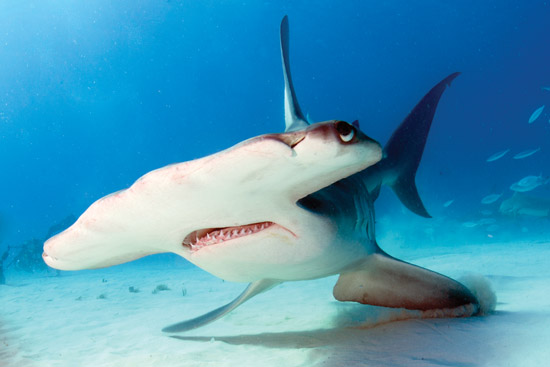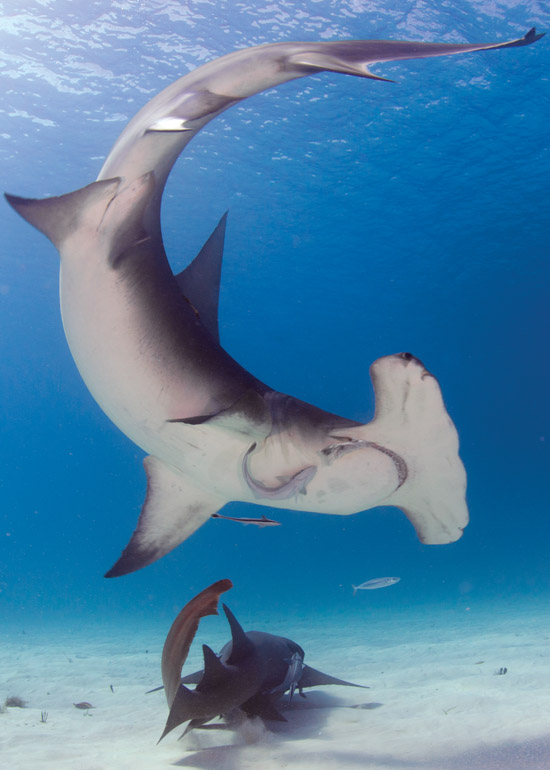Hammered on Bimini: Getting shark-faced in the Bahamas

Text and Photography by Andy Murch
You would think that a large, globally occurring species like the great hammerhead would be a relatively easy shark to encounter but until a couple of years ago that simply wasn’t the case. Shark diving operators in the Bahamas and elsewhere raved about dive sites where hammerheads occasionally made an appearance but it was far from a sure thing. Even when one did slip out of the blue with its broad T-shaped hammer and tall, sickle-shaped dorsal fin, invariably it was shy around divers.
When the great hammerhead (Sphyrna mokarran) was officially listed as endangered by the International Union for Conservation of Nature and Natural Resources (IUCN) it looked as though there would never be a reliable place to swim with these iconic animals, but in the spring of 2012 just off an island a mere 70 miles (115km) east of Miami, Florida, everything changed.
Long is the legend of South Bimini Island’s ‘Harbour Master’, a huge hammerhead shark (most likely many different individuals) on constant patrol for eagle rays, stingrays and fish scraps discarded by local fishermen. Unknown to the dive world at large, great hammerheads have been showing up in long-lining surveys conducted by the Bimini Shark Lab for decades but it wasn’t until 2010 that shark lab alumni Grant Johnson and Katie Grudecki began actively studying their behaviour.

Tags That Tell
To better protect the local population, the researchers needed to determine whether the hammers were seasonal residents or transient wanderers. They also wanted to find out exactly where they went after they deserted Bimini in late spring each year. They decided that the best way to identify individual animals was to attract them with bait and then tag them with a pole spear while free diving. The tagging method was important because great hammerheads are very easily stressed and have a low survival rate after spending time on a hook and line.
Grant and Katie’s initial tagging project showed that some individuals returned to Bimini year after year. Armed with this information the shark lab was able to get funding to set up a more elaborate tagging study that involved the installation of 20 acoustic tags and an array of acoustic receivers that formed a perimeter around the island. Whenever a shark went past one of the receivers, a unique code was generated that showed the daily movements of that individual animal.
The acoustic receiver array was part of a larger network of receivers that were installed for studying different species all along the east coast of North America. By utilizing the larger network, the staff at Bimini is beginning to establish how far north some great hammerheads are traveling each year. In 2013, one athletic individual from Bimini pinged a receiver installed half way up the Eastern Seaboard in Virginia Beach.

Bait Crates
Inevitably, news of the tagging study and the apparent abundance of great hammerhead sharks around Bimini reached the dive world. In 2012, renowned Bahamian shark diving operator Stuart Cove invited a handful of professional photographers on an exploratory expedition to search for the Harbour Master and his lookalikes. The trip was a great success and the subsequent publicity resulted in an armada of liveaboards and dive operators converging on the island at the start of 2013. A new shark diving mecca was born.
Not wanting to ‘miss the boat’ I too made the pilgrimage to Bimini. After chasing shadows in a slew of other supposed hammerhead hot spots, I was rather skeptical but local dive operator Neil Watson assured me that Bimini was the real deal. He was right. A stone’s throw from Bimini Sands Marina we dropped anchor in 20 feet (6m) of water and set about the business of attracting sharks. Grant Johnson (now working full time for Neal) dropped a pungent crate of fish heads into the drink and we sat on deck discussing shark politics while the blood and fish oil worked its way down current.
Nurse sharks were the first to arrive; five or six brown shapes clearly visible milling around on the sand. Next came the bull sharks: two, then three rotund silhouettes moving faster and with more purpose. Still we sat on deck although I was itching to slip on a tank and play with the bulls. Then finally, Grant (who was snorkeling by this time) lifted his head and screamed, “Hammerhead!”
Donning tanks, we descended as a group and formed a line looking down current. Neil and Grant took point, both armed with oozing bait crates and feeding poles. Aligning myself next to one of the feeders, I laid on my belly, camera poised and waited for the hammer to close the gap. It took maybe five minutes for the 13-foot (4m) long female to pluck up the courage to approach closely but when she did, the width of her hammer eclipsed everything in my view.
Grant had thrown a scrap about a meter in front of me and was busy fending off nurse sharks that were weaving around the divers, vacuuming up anything that smelled vaguely fishy. The scrap finally caught the eye of the approaching hammerhead and I could see her visibly switching gears. With one quick flick of her tail she was over the bait but she missed it on the first pass. Her meter wide hammer was great for pinning down stingrays but at close quarters her eyes were too far apart to pinpoint small objects. Turning on a dime she came in for another run, moving her head left and right like a beachcomber scanning the sand with a metal detector. Finally locating the scrap, she simply opened her voluminous maw and the scrap and adjacent sand was sucked into her belly.

Late Risers
Looking up, I noticed that another great hammerhead had entered the fray. Although they dwarfed the bulls and nurse sharks, the hammers seemed overwhelmed by the amount of predators in attendance. Rather than pushing the smaller sharks aside as one might expect, they would cruise back and forth waiting for an opening.
The feeders were very careful about who got fed and who didn’t. Neil later explained that they never intentionally feed the bull sharks because they are such an easily excitable species. They feel that if the bulls get a taste they will become too aggressive to safely dive with and they could easily chase away the hammerheads. Even without food, they are becoming bolder each year.
Over the next few days we settled into a predictable routine. The hammerheads were late risers, rarely showing up until noon but, unlike some shark species, once they appeared they generally stuck around until we pulled anchor at sunset. On our most productive day we counted nine different great hammerheads and countless nurses and bulls. The largest was an enormous five-meter long female with a hammer that was wider than my outstretched camera strobe arms. It occurred to me that this behemoth animal could well be the original Harbour Master.
With more great hammerhead shark images than I could ever hope to use, I opted for a change of pace. Neal also conducts a shark dive at three small pinnacles known as Triangle Rocks where Caribbean reef sharks and Blacknose sharks can often be seen.
While the other divers enjoyed an exciting couple of hours among the resident reef sharks, I went on the hunt for one of their tiny meter long cousins.
Sure enough, there were three timid Blacknoses skirting the edge of the shark feed and by avoiding eye contact and holding my breath to the point of hypoxia, I was able to drift close enough to snap some satisfying ID images before the pint-sized predators darted away. Mission accomplished.
Before my flight home, I attended a talk at the Shark Lab to learn more about their research projects and to photograph the baby Lemon sharks that they have been studying for decades in the adjacent lagoon. I asked them if the influx of divers was changing the behavior of the hammerheads. So far, so good, they said. The area where the diving takes place is part of the hammers’ natural hunting grounds so they would be there anyway even if they weren’t being fed, and no amount of chumming has been able to keep them around past April when they should be migrating north. That’s good news because the shark diving operators are here to stay. Bimini is officially on the map.
For more information on diving with hammerheads visit Big Fish Expeditions.








